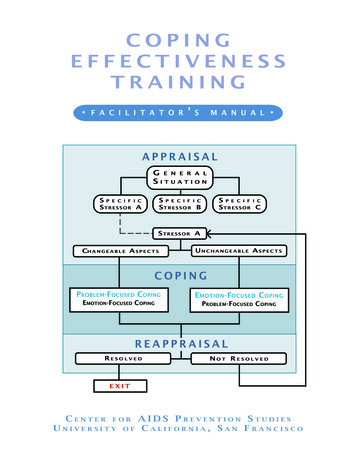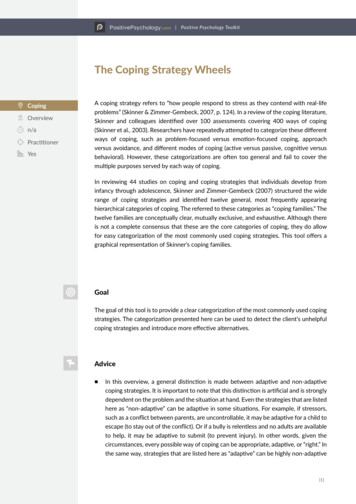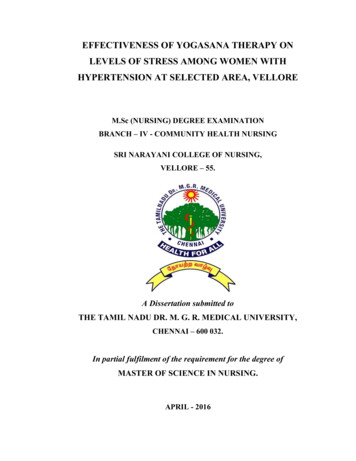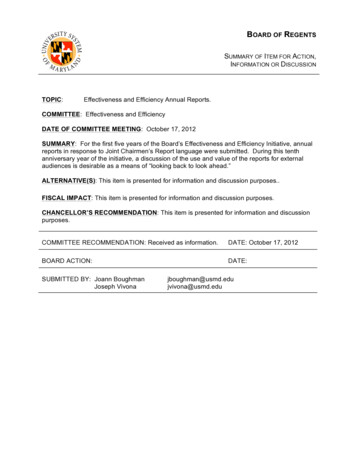
Transcription
COPINGEFFECTIVENESSTRAINING F A C I L I T A T O R'SM A N U A L APPRAISALG E N E R A LSITUATIONS P E C I F I CST R E S S O R AS P E C I F I CST R E S S O R BS P E C I F I CST R E S S O R CST R E S S O R ACH A N G E A B L E A S P E C T SUNCHANGEABLE ASPECTSCOPINGP ROBLEM-FOCUSED COPINGEMOTION -FOCUSED C OPINGEMOTION -FOCUSED C OPINGPROBLEM -F OCUSED C OPINGREAPPRAISALRESOLVEDNOT RESOLVEDEXITCENTERFORUNIVERSITYOFAIDS PREVENTION STUDIESCALIFORNIA, SAN FRANCISCO
COPINGEFFECTIVENESSTRAINING F A C I L I T A T O RCENTERSM A N U A L AIDS PREVENTION STUDIESFORUNIVERSITY'OFCALIFORNIA, SAN FRANCISCODevelopment of this manual was supportedby NIMH grant MH57233COPYRIGHT 1997DO NOT COPY WITHOUT PERMISSION2.98
COPINGEFFECTIVENESSTRAINING F A C I L I T A T O RDEDICATEDWHOHAVETO'OURSM A N U A LPARTICIPANTSTAUGHTUSSOMUCH
C O P I N GE F F E C T I V E N E S ST R A I N I N GPREFACE:SESSION I:SESSION II:SESSION III:T A B L EO FCONTENTSCOPING EFFECTIVENESS TRAINING FACILITATOR’S MANUAL . 1THE INTERVENTION PROGRAM . 2GROUP FACILITATION . 3Communication Skills . 4Summarizing . 5Mediating Conflict . 6Modeling . 7Role Playing. 7Group Discussion . 8Dyads and Triads . 8Brainstorming . 9INTRODUCTION TO COPING EFFECTIVENESS TRAINING . 10OVERVIEW . 10GOALS . 10LEADER INTRODUCTIONS . 11GROUP MEMBER INTRODUCTIONS . 13WHAT IS STRESS? . 13STRESSFUL EVENTS — DYAD . 13PERSONAL SYMPTOMS OF STRESS . 14STRESS IS A PERSONAL EXPERIENCE . 15MANAGING STRESS . 15INTRODUCE THE COPING EXERCISES . 16Why do them? . 16Why not do them (Barriers) . 16Exercises for next week . 16ENDING THE GROUP . 17CET: FIRST STEPS . 18OVERVIEW . 18GOALS . 18GROUP CHECK-IN . 19REVIEW EXERCISES FROM SESSION 1 . 19POSITIVE EXPERIENCES . 19COMMUNICATION SKILLS: LISTENING AND ACKNOWLEDGING . 20INTRODUCE COPING . 21Definition . 21General Conditions vs. Specific Situations . 21BREAKING GENERAL SITUATIONS INTO SPECIFIC EVENTS — DYAD . 22EXERCISES . 23VISUALIZATION EXERCISE . 23EMOTION-FOCUSED COPING . 25OVERVIEW . 25GOALS . 25GROUP CHECK-IN . 26REVIEW EXERCISES FROM SESSION 2 . 26CHANGEABLE AND UNCHANGEABLE SITUATIONS . 26TWO MAJOR TYPES OF COPING . 27F A C I L I T A T O R'SM A N U A LPAGEIV
C O P I N GE F F E C T I V E N E S ST R A I N I N GT A B L EO FCONTENTSEMOTION-FOCUSED COPING . 28THE THREE O’S . 30EXERCISES . 31CLOSING EXERCISE . 31SESSION IVEMOTION-FOCUSED LISTENING ANDPROBLEM-FOCUSED COPING . 32OVERVIEW . 32GOALS . 32GROUP CHECK-IN . 33REVIEW EXERCISES FROM SESSION 3 . 33COMMUNICATION SKILLS: FOCUS ON EMOTION . 33EMOTION-FOCUSED LISTENING . 34PROBLEM-FOCUSED COPING . 34THE THREE O’S REPRISE . 35PROBLEM-FOCUSED COPING DYADS . 36THE LITTLE THINGS MATTER . 36PROBLEM-FOCUSED & EMOTION-FOCUSED COPING ARE INTERTWINED . 37EXERCISES . 37CLOSING EXERCISE . 38RETREAT DAY . 39OVERVIEW . 39GOALS . 39PURPOSE OF THE DAY . 40STRESSFUL SITUATIONS RELATED TO HIV . 40BREAK . 41AEROBIC EXERCISE . 41RELAXATION EXERCISE . 41LUNCH AND AFTER-LUNCH WALK . 45RETURN TO HIV STRESSORS LIST . 45BREAK . 47AFFIRMATIONS . 47RE-ENTRY . 48SESSION V:RETREAT REVIEW . 49OVERVIEW . 49GOALS . 49GROUP CHECK-IN . 50REVIEW RETREAT . 50AFFIRMATIONS . 50GAINING POWER AND MOBILIZING . 50EXERCISE . 51RELAXATION OR VISUALIZATION EXERCISE . 51SESSION VI: NEGOTIATION SKILLS . 52OVERVIEW . 52GOALS . 52GROUP CHECK-IN . 53REVIEW EXERCISES FROM SESSIONS 4 & 5 . 53F A C I L I T A T O R'SM A N U A LPAGEV
C O P I N GE F F E C T I V E N E S ST R A I N I N GT A B L EO FCONTENTSINTRODUCE NEGOTIATION . 53Interpersonal Stress . 53Goals of Negotiation . 54PHASES OF NEGOTIATION . 54Phase 1: Entry . 54Phase 2: Exploration . 54Phase 3: Give and Take . 54Phase 4: Closing . 54When the Other Person Will Not Negotiate . 55Getting More Information . 55MODEL PHASES OF NEGOTIATION . 55ROLE PLAY — NEGOTIATION . 57EXERCISE . 57RELAXATION OR VISUALIZATION EXERCISE . 57SESSION VII: GIVING & RECEIVING SOCIAL SUPPORT (PART 1) . 58OVERVIEW . 58GOALS . 58GROUP CHECK-IN . 59REVIEW EXERCISES FROM SESSION 6 . 59TYPES OF SUPPORT . 59THE CONCENTRIC CIRCLES OF SOCIAL SUPPORT . 60Self at Center . 60Self as Part of Another’s Network . 60THE IMPACT OF THE HIV EPIDEMIC ON SOCIAL SUPPORT NETWORKS . 61GIVING SUPPORT . 62Your Support Forte . 62Impact on You of Providing Support . 63Requests for Support . 63Saying No . 63EXERCISES . 64BRIEF RELAXATION EXERCISE . 64SESSION VIII: GIVING & RECEIVING SOCIAL SUPPORT (PART II) . 65OVERVIEW . 65GOALS . 65GROUP CHECK-IN . 66REVIEW EXERCISES FROM SESSION 7 . 66RECEIVING SUPPORT . 66SOCIAL SUPPORT SKILLS . 67Finding The Support You Want . 67Appreciating The People Who Help You . 70Saying No to Help You Don’t Want . 70SOCIAL SUPPORT ROLE PLAY AND DISCUSSION . 70Role Play . 70Discussion . 71EXERCISES . 72RELAXATION OR VISUALIZATION EXERCISE . 72F A C I L I T A T O R'SM A N U A LPAGEVI
C O P I N GE F F E C T I V E N E S ST R A I N I N GSESSION IX:SESSION X:SESSION XI:SESSION XII:T A B L EO FCONTENTSCOPY OF EXERCISES DONE IN GROUP . 73THINKING ABOUT PRIORITIES . 75OVERVIEW . 75GOALS . 75GROUP CHECK-IN . 76REVIEW EXERCISES FROM SESSION 8 . 76INTRODUCION . 76CONCEPT OF REGOALING . 76USING CET SKILLS . 78PERSONAL VALUES AND PRIORITIES . 78EXERCISES . 78RELAXATION OR VISUALIZATION EXERCISE . 79COPING SABOTAGE . 80OVERVIEW . 80GOALS . 80GROUP CHECK-IN . 81REVIEW EXERCISES FROM SESSION 9 . 81INTRODUCTION TO SELF-SABOTAGE . 81Self-Sabotaging Statements . 81Common Forms of Self-Sabotage . 82CLOUDS OF SELF-SABOTAGE . 84EXERCISES . 84RELAXATION OR VISUALIZATION EXERCISE . 84RECOVERING FROM COPING SABOTAGE . 85OVERVIEW . 85GOALS . 85GROUP CHECK-IN . 86REVIEW EXERCISES FROM SESSION 10 . 86SELF-SABOTAGE RECOVERY . 86Clouds of Recovery . 86Self-Enhancing & Self-Defeating Thoughts . 87Immunize Against Failure . 87EXERCISES . 87ANNOUNCEMENTS . 87RELAXATION OR VISUALIZATION EXERCISE . 87CHANGES . 88OVERVIEW . 88GOALS . 88GROUP CHECK-IN . 89REVIEW EXERCISES FROM SESSION 11 . 89DISCUSS TRANSITION FROM WEEKLY TO LESS FREQUENT MEETINGS . 89PARTICIPANT FEEDBACK (WRITTEN) . 90PARTICIPANT FEEDBACK (ORAL) . 90CONCLUDING THE 12TH GROUP . 91F A C I L I T A T O R'SM A N U A LPAGEVII
C O P I N GE F F E C T I V E N E S ST R A I N I N GP R E F A C ECOPING EFFECTIVENESS TRAININGFACILITATOR'S MANUALCENTERFORUNIVERSITYOFAIDS PREVENTION STUDIESCALIFORNIA, SAN FRANCISCOThe purpose of Coping Effectiveness Training (CET) is toteach people skills for coping with stress — from dailyhassles to major life events. The program brings togetherrecent developments in the theory of stress, coping andhealth with advances in stress management. Stress and coping theory emphasizes two processes, appraisal and coping,as mediators of the relationship between stress and anindividual’s psychological and physiological reactions. Although CET is a manualized intervention program, it seeksnot to be merely a “mechanical application of techniques”(Castonguay, Goldfried, Wiser, Raue & Hayes, 1996). Facilitators attempt to strike a balance between delivering theintervention and maintaining flexibility so that they do notget bogged down in the particular language or techniques.CET is a work in progress. Much of what you will see inboth the Facilitator’s Manual and the Participant’s Workbookis currently under revision. We welcome your feedback onwhat you will read in the pages that follow.Appraisal refers to the individual’s evaluation of a particular personally meaningful situation. Whether or not a situation is stressful is based on how each person evaluates thesituation. What is a major stressor for one person may be aminor event to another. The difference is how the two peopleperceive and evaluate the situation.Coping refers to what individuals do in response to situations that they appraise or evaluate as stressful. Copingcan be internal in the form of thoughts or can be externalactions. The overarching question that determines the rangeof adaptive coping options is whether or not the outcome ofthe situation can be changed. The range of options is alsoinfluenced by the person’s resources for coping, includingpsychological, social, material and physical resources.F A C I L I T A T O R'SM A N U A LPAGE1
C O P I N GE F F E C T I V E N E S ST R A I N I N GP R E F A C ECoping has two main functions. First, it can help addressthe problems that give rise to stress. This is referred to asproblem-focused coping. Second, it can help regulate feelings that arise from stress including anxiety, anger and sadness. This is referred to as emotion-focused coping. Ingeneral, the best fit occurs when people use problem-focusedcoping in situations that are changeable and use emotionfocused coping in situations that are not changeable.Stress management strategies can be categorized as primarily problem-focused or emotion-focused. Problem-focusedcoping, for example, relies on problem-solving strategies,communications and interpersonal negotiation skills. Emotion-focused coping includes adaptive strategies such ascognitive reframing or restructuring and humor. There arealso maladaptive emotion-focused strategies such as overuse of drugs or alcohol.With CET, stress and coping theory supplies the frameworkin terms of training individuals to: be specific about the stress they encounter, and to be explicit about the extent to which each source of stress ischangeable.Then, stress management supplies the coping strategies,fitting the strategies to each source of stress, so that: problem-focused strategies are applied to stressors that can bechanged, and emotion-focused strategies are applied to stressors that cannot be changed.THE INTERVENTION PROGRAMThe intervention program emphasizes training in appraisal,emotion-focused coping, problem-focused coping, the useof social support and the maintenance of coping skills overtime.F A C I L I T A T O R'SM A N U A LPAGE2
C O P I N GE F F E C T I V E N E S ST R A I N I N GP R E F A C E Appraisal training emphasizes identifying specific personallymeaningful stressful situations (as opposed to global chronicconditions), and distinguishing between changeable and unchangeable aspects of these situations. Emotion-focused training emphasizes relaxation and distancing skills that are useful for reducing distress when dealingwith chronic threat and unchangeable situations. Problem-focused training emphasizes the development of problem-solving skills for use in changeable situations includingcommunication, decision-making, and negotiation. Social support training emphasizes the development of skillsto achieve a fit between the type of support one needs and thetype of support that can be obtained from various support providers. Maintenance training emphasizes the identification of forcesthat will interfere with maintenance of coping skills and thedevelopment of strategies to counteract these forces.GROUP FACILITATIONThis section includes a review of some of the fundamentalsof group facilitation and some guidelines for leading CETgroups. 1The effectiveness of a CET group depends, in large measure,on its facilitators.As a CET group facilitator, you can help to enhance the effectiveness of your group by following some guidelines. Create an emotionally safe setting. Bring a positive attitude. Encourage group members to share their ideas andfeelings. Build on group members’ knowledge and experience. Avoid sermon giving. Remain aware of goals.F A C I L I T A T O R'SM A N U A LThis section on group facilitation is adapted from theWomen's Health InitiativeGroup Nutritionist Manual.1.PAGE3
C O P I N GE F F E C T I V E N E S ST R A I N I N GP R E F A C EA major part of your job is to introduce the session topicand guide the discussion or exercises. At appropriate times,you will summarize or encourage members to summarizewhat has been going on in the group.In CET groups, participants have the opportunity to interact with others who have faced similar difficulties. Peoplewho are HIV-positive bring an enormous amount of experience and expertise in a variety of areas to a CET group.Although at times you will need to provide examples in order to clarify a concept, more often than not, the groupmembers’ experiences will provide examples more meaningful to them than examples you bring in from outside. Integrate participants’ expertise and experience with the skillsyou are teaching for coping with stress. Using participants’knowledge lets them know you are listening and that youare concerned about them.In addition, active participation by the group members tendsto increase their self-esteem, and encourages them to continue participating. It tends to confer a sense of belongingor ownership of the group – a sense that “this is my group.”Finally, it allows you to get to know the participants betterand to learn from them.Communication SkillsTry to involve all participants in the groups’ process. Encourage those who are quiet, and control those who dominate the group interaction.Develop rapport by responding to participants’ feelings andneeds. Communicate empathic understanding through bothyour verbal and non-verbal actions. See your participantsas capable. Each will bring something valuable to the group.Express appropriate warmth and friendliness.Provide encouragement, support and appropriate challengesto the group.Listen and attend to what people say so that they know youare paying close attention and you value their thoughts,ideas, and feelings.F A C I L I T A T O R'SM A N U A LPAGE4
C O P I N GE F F E C T I V E N E S ST R A I N I N GP R E F A C EAmong the members of CET groups, you will encounter differing language patterns and styles, various cultural andethnic backgrounds, a range of communication skills, varying abilities to absorb and retain information, differentialwillingness to disclose personal information, and differinglevels of concrete or abstract thinking abilities.A few guidelines: Elicit information, ideas, examples from the group. Use common language. If you have information to give, givethe most important part first, and give it one piece at a time. Ifyou are giving information, be sure it is necessary and useful. Give reasons for seeking and giving information. Tell participants why you want the information and how you plan to useit. Encourage differing viewpoints to be voiced. Do not show biasfor certain answers in your tone of voice. Listen for feelings. Attend to how content is given. Respond tothe “how” rather than only to the content. Sometimes it will beappropriate to respond to feelings verbally and directly. Othertimes you will note the feelings to yourself and respond to themmore indirectly.SummarizingWhen: At the beginning of a CET group, you may summarize from theprevious meeting so that everyone begins the present groupfrom common ground. Clarification is needed. It is time to move the group along to the next step. At the end of a CET meeting to provide closure. If you are notable to cover all the segments of any particular session, state inyour summary that not everything has been covered. Tell participants that you will address the areas not covered during thenext meeting.F A C I L I T A T O R'SM A N U A LPAGE5
C O P I N GE F F E C T I V E N E S ST R A I N I N GP R E F A C EHow: Be brief. Highlight major points. Omit any nonessential information. Include only information already discussed. This is not thetime to add anything new. You, the facilitator, may summarize. Alternatively, you mayask the group members to summarize and guide them in theprocess.Who:Mediating ConflictSometimes conflict will arise between participants. Mosttimes, the facilitator must play a neutral role in order tomanage and use disagreements. Disagreements related todifferences in appraisal may occur.Guidelines: Listen to each side and paraphrase what each participant hassaid. Clarify the issues. Point out common elements, and note areas of disagreement.Discuss possible options: Get more information. Seek a compromise position. Ask for ideas or feedback from the group. Encourage groupparticipants to help each other in resolving disputes. Agree to table the issue temporarily (e.g., to let tempers cool)and to revisit it later (maybe next week). Agree to disagree. Agreeing to disagree may be a helpful approach when disagreements about appraisal occur. Relatingthe disagreement back to the discussion of appraisal may beparticularly helpful.F A C I L I T A T O R'SM A N U A LPAGE6
C O P I N GE F
TRAINING FACILITATOR' S MANUAL PAGE1 PREFACE COPING EFFECTIVENESS TRAINING FACILITATOR'S MANUAL CENTER FOR AIDS PREVENTION STUDIES UNIVERSITY OF CALIFORNIA, SAN FRANCISCO The purpose of Coping Effectiveness Training (CET) is to teach people skills fo










